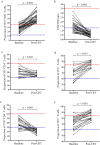Effect of chemoradiotherapy on the proportion of circulating lymphocyte subsets in patients with limited-stage small cell lung cancer
- PMID: 33674986
- PMCID: PMC10991102
- DOI: 10.1007/s00262-021-02902-x
Effect of chemoradiotherapy on the proportion of circulating lymphocyte subsets in patients with limited-stage small cell lung cancer
Erratum in
-
Correction to: Effect of chemoradiotherapy on the proportion of circulating lymphocyte subsets in patients with limited‑stage small cell lung cancer.Cancer Immunol Immunother. 2021 Oct;70(10):2877-2879. doi: 10.1007/s00262-021-02929-0. Cancer Immunol Immunother. 2021. PMID: 33860343 Free PMC article. No abstract available.
Abstract
Objective: Chemoradiotherapy (CRT) is the standard treatment for limited-stage small cell lung cancer (LS-SCLC), which can exert anti-tumor effects by regulating immune cells. Different immune cell subsets are associated with a specific sensitivity to CRT. The purpose of this study was to characterize the proportion or composition of peripheral lymphocytes in patients with LS-SCLC before and after CRT, and evaluate their prognostic value.
Methods: A total of 98 patients with LS-SCLC were enrolled. The expression of CD3, CD4, CD8, CD45RA, CD45RO, CD38, CD56, and CD19 on the surface of peripheral blood cells was detected by flow cytometry and retrospectively analyzed. The relationship between the proportion of lymphocyte subsets, progression-free survival (PFS), and overall survival (OS) was evaluated using a log-rank test and Cox regression model.
Results: The median PFS was 12.3 months and the median OS was 21.7 months. Compared with the pre-treatment specimens, post-treatment lymphocytes had increased proportions of CD3+, CD3+CD8+, CD8+CD38+ T cells, and NKT cells, and a decreased proportion of CD3+CD4+ T cells, CD4+CD45RA+ T cells, B cells, NK cells, and CD4/CD8 ratio. Univariate and multivariate analyses showed that prophylactic cranial irradiation, high percentages of CD4+CD45RA+, CD8+CD38+ T cells after CRT independently predicted superior PFS. Male patients with a high baseline CD4+CD45RO+ T cell ratio predicted a poor OS.
Conclusions: CRT induced changes in the proportion of circulating lymphocyte subsets in LS-SCLC, which is helpful for designing a regimen of immune drugs to be combined with CRT. The prognostic value of the proportion of lymphocytes aids in understanding the role of peripheral immune profiles in LS-SCLC.
Keywords: Chemoradiotherapy; Lymphocyte subsets; Small cell lung cancer.
© 2021. The Author(s), under exclusive licence to Springer-Verlag GmbH, DE part of Springer Nature.
Conflict of interest statement
None of the authors had any conflicts of interest to declare.
Figures




Similar articles
-
Aberrant Alteration of Circulating Lymphocyte Subsets in Small Cell Lung Cancer Patients Treated with Radiotherapy.Technol Cancer Res Treat. 2021 Jan-Dec;20:15330338211039948. doi: 10.1177/15330338211039948. Technol Cancer Res Treat. 2021. PMID: 34851203 Free PMC article.
-
Effect of chemoradiotherapy on the dynamics of circulating lymphocyte subsets in patients with non-metastatic nasopharyngeal carcinoma.Front Oncol. 2025 Feb 12;15:1521836. doi: 10.3389/fonc.2025.1521836. eCollection 2025. Front Oncol. 2025. PMID: 40012553 Free PMC article.
-
[Prognostic evaluation of nutritional indicators in patients with limited-stage small cell lung cancer].Zhonghua Zhong Liu Za Zhi. 2019 Dec 23;41(12):937-942. doi: 10.3760/cma.j.issn.0253-3766.2019.12.010. Zhonghua Zhong Liu Za Zhi. 2019. PMID: 31874552 Chinese.
-
Chemoradiotherapy-Induced CD4+ and CD8+ T-Cell Alterations to Predict Patient Outcomes in Esophageal Squamous Cell Carcinoma.Front Oncol. 2019 Feb 15;9:73. doi: 10.3389/fonc.2019.00073. eCollection 2019. Front Oncol. 2019. PMID: 30828566 Free PMC article.
-
[Deep lung--cellular reaction to HIV].Rev Port Pneumol. 2007 Mar-Apr;13(2):175-212. Rev Port Pneumol. 2007. PMID: 17492233 Review. Portuguese.
Cited by
-
The current understanding of the immune landscape relative to radiotherapy across tumor types.Front Immunol. 2023 Mar 16;14:1148692. doi: 10.3389/fimmu.2023.1148692. eCollection 2023. Front Immunol. 2023. PMID: 37006319 Free PMC article. Review.
-
Pilot trial of topical MTS‑01 application to reduce dermatitis in patients receiving chemoradiotherapy for stage I‑III carcinoma of the anal canal.Int J Oncol. 2022 Jun;60(6):68. doi: 10.3892/ijo.2022.5358. Epub 2022 Apr 19. Int J Oncol. 2022. PMID: 35438186 Free PMC article. Clinical Trial.
-
A nomogram model based on peripheral blood lymphocyte subsets to assess the prognosis of non-small cell lung cancer patients treated with immune checkpoint inhibitors.Transl Lung Cancer Res. 2021 Dec;10(12):4511-4525. doi: 10.21037/tlcr-21-899. Transl Lung Cancer Res. 2021. PMID: 35070757 Free PMC article.
-
Circulating Leukocyte Subsets Before and After a Breast Cancer Diagnosis and Therapy.JAMA Netw Open. 2024 Feb 5;7(2):e2356113. doi: 10.1001/jamanetworkopen.2023.56113. JAMA Netw Open. 2024. PMID: 38358741 Free PMC article.
-
Changes of proportions of circulating lymphocyte subsets in cancer patients after chemotherapy.Transl Cancer Res. 2021 Sep;10(9):4169-4179. doi: 10.21037/tcr-21-1688. Transl Cancer Res. 2021. PMID: 35116713 Free PMC article.
References
-
- Paz-Ares L, Dvorkin M, Chen Y, et al. Durvalumab plus platinum-etoposide versus platinum-etoposide in first-line treatment of extensive-stage small-cell lung cancer (CASPIAN): a randomised, controlled, open-label, phase 3 trial. Lancet. 2019;394:1929–1939. doi: 10.1016/S0140-6736(19)32222-6. - DOI - PubMed
MeSH terms
Grants and funding
LinkOut - more resources
Full Text Sources
Other Literature Sources
Medical
Research Materials

